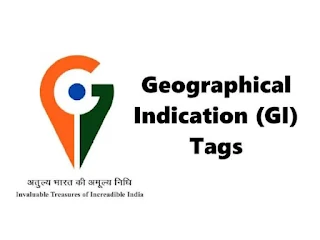
- GI tags help to protect the authenticity and uniqueness of such products, as well as promote their economic and cultural value.NABARD (National Bank for Agriculture and Rural Development) has supported the project for GI registration of five traditional artworks of Rajasthan, namely:
- Jodhpur Bandhej work: A tie-and-dye technique of fabric printing that creates intricate patterns and vibrant colors.
- Koftagiri Metal Craft of Udaipur: A metal engraving art that involves hammering thin sheets of metal on wooden or metal objects and then filling the grooves with colored lacquer.
- Nathdwara Pichhwai craft of Rajsamand: A cloth painting art that depicts scenes from the life of Lord Krishna and his devotees, usually hung behind the idol of Shrinathji in temples.
- Bikaner Usta Kala: A hand embroidery art that uses gold or silver threads and precious stones to embellish leather, wood, marble, or ivory objects.
- Hand embroidery art of Bikaner: A needlework art that uses various stitches and threads to create floral, geometric, or animal motifs on fabrics.
- The GI tags will help to preserve the intactness of the disappearing artworks, safeguard the traditional knowledge and cultural expressions of the state, enhance the product quality and market access, create awareness and strengthen the producer’s capacity to enforce their rights, and empower the local communities by enhancing their income levels.
Question:
Q.1 Which of these artworks is not part of the five traditional artworks of Rajasthan that received GI tags with NABARD’s support?a. Jodhpur Bandhej work
b. Koftagiri Metal Craft of Udaipur
c. Nathdwara Pichhwai craft of Rajsamand
d. Jaipur Blue Pottery


